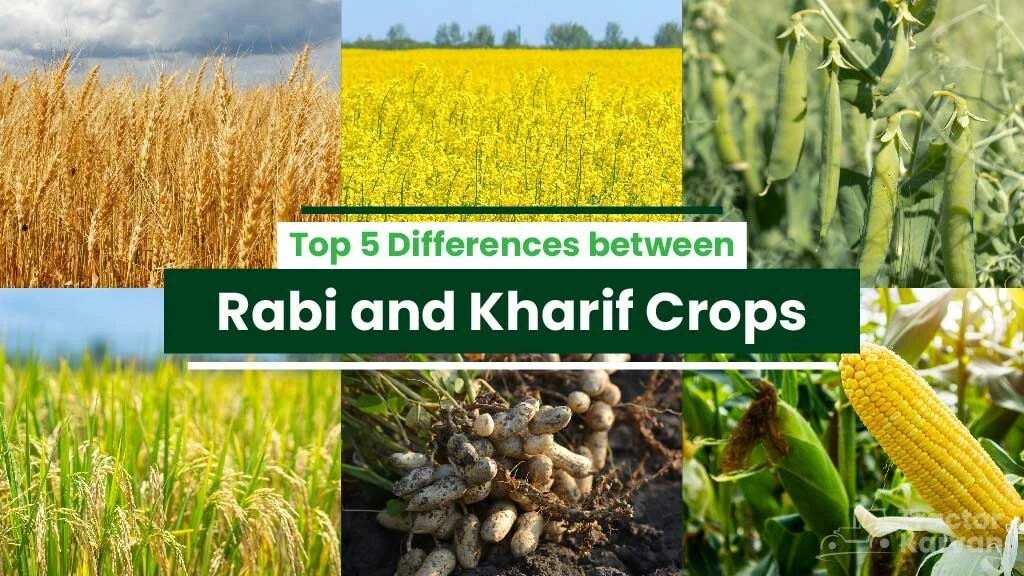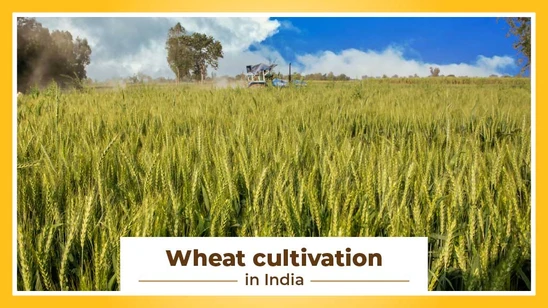Top 5 Differences between Rabi and Kharif Crops in India

Table of Contents
- Introduction
- What are Kharif and Rabi Crops?
- Top 5 Differences between Rabi and Kharif Crops
- Importance of Rabi Crops and Kharif Crops
- Conclusion
Introduction
India is a vast country with a diverse climate. It allows for a wide variety of crops to be grown. The two main cropping seasons in India are Rabi and Kharif. These Rabi and Kharif crops play a vital role in determining the country's food production and overall agricultural performance.
What are Kharif and Rabi Crops?
All farmers must have an idea about what is Kharif crop and Rabi crop. The success of Rabi and Kharif crops directly impacts rural economies. They provide income to farmers and support various related industries like food processing, transportation, and agribusiness. In the given sections below let us understand about Kharif and Rabi crops in brief.
Kharif Crops
The Kharif season months coincides with the start of summer and ends with autumn. Kharif is an Arabic word which means autumn. These crops sowing starts in the monsoon season and called monsoon crops also. The specific duration of the Kharif season can vary state-wise, but it typically spans from June to September throughout the country.
Planting typically commences at the start of the monsoon season, around June. Harvesting happens in the month of September or October. Kharif crops cover a wide range of produce, including cotton, soybean, peanut, bajra, maize, ragi and rice.
Rabi Crops
Rabi means spring in Arabic, which also translates to ‘new life.’ Crops harvested during this are called spring crops also. The Rabi crop season commences in November and continues until March/April. Due to the lack of monsoon rains, the primary method of cultivating Rabi crops involves use of irrigation.
It is worth noting that untimely rainfall in November/December can damage the crop yield. Seed sowing is done around the end of autumn. The harvest takes place in the subsequent spring. Among the crucial Rabi crops cultivated in India are barley, green peas, mustard, and wheat.
India stands at the second place when it comes to producing wheat. The nation heavily relies on the cultivation of this Rabi crop for its agricultural income. Wheat serves as a staple grain for the Indian population, especially in the country's northern regions.
Top 5 Differences between Rabi and Kharif Crops
Distinct weather patterns and crop cultivation practices characterise the Kharif and Rabi season. Learn more about the difference between Rabi and Kharif crops in this section.
Kharif and Rabi Season
The most fundamental difference between Rabi crop and Kharif crop is the season in which they are cultivated:
- Rabi Crops: Rabi crops are sown during the winter season. It is typically between November and December. These crops are harvested in the spring, from March to May.
- Kharif Crops: Kharif crops are sown with the onset of the monsoon season. It is usually between June and July. The fully-grown crops are harvested in the autumn, from September to October. These crops are suitable for rain-fed agriculture and require a significant amount of water.
Climatic Conditions
Climatic conditions have a crucial role in determining the choice of crops for each season:
- Rabi Crops: Rabi crops are grown during the cool winter season, benefiting from the relatively low temperatures. These crops are mostly grown in regions where the climate is dry and cold but favourable for crop cultivation.
Rabi crops are grown in states like Punjab, Haryana, Uttar Pradesh, Rajasthan, and Madhya Pradesh.
- Kharif Crops: Kharif crops are cultivated during the monsoon season, with abundant rainfall and high temperatures. These crops are suitable for regions with tropical and subtropical climates. They are characterised by hot summers and adequate rainfall.
Kharif crops are grown in states like Andhra Pradesh, Maharashtra, Karnataka, and West Bengal.
Monsoon Dependency
Another significant difference between Rabi crop and Kharif crop is the reliance on monsoon rainfall:
- Rabi Crops: Rabi crops are less dependent on rainfall as they are grown during the dry winter season. Farmers mainly rely on irrigation methods like canals, tube wells and reservoirs to provide water for Rabi crops.
- Kharif Crops: Kharif crops heavily depend on the monsoon rains. They provide the necessary moisture for their growth. These crops are more vulnerable to variations in monsoon patterns. It makes their cultivation riskier.
Crop Diversity
Crop diversity is a major rabi crops and kharif crops difference. The types of crops cultivated during the Rabi and Kharif seasons differ significantly.
- Rabi Crops: Rabi season exhibits more crop diversity compared to the Kharif season. Rabi crops include a wide range of cereals, pulses, gram, and oilseeds. They provide a range of food products and raw materials for industries.
- Kharif Crops: Kharif crops consist of rice, cotton, maize and other crops that require high water availability. They are staples in many parts of India. Kharif crops are known for their water-intensive nature and are well-suited to the monsoon climate.
Harvesting Period
The last Rabi crops and Kharif crops difference is the timing of harvesting. This harvesting period differs due to the distinct growing seasons:
- Rabi Crops: Rabi crops harvest period falls in the spring, from March to May. The dry and cool climate during this period is conducive to harvesting and storage.
- Kharif Crops: Kharif crops harvest period falls in the autumn, from September to October. The moisture content in the soil and air during this season can pose challenges for harvesting and post-harvest storage.
Here is a Rabi and Kharif crops chart summarizing the key differences:
|
Feature |
Rabi Crops |
Kharif Crops |
|
Sowing Season |
October-December |
June-July |
|
Harvesting Season |
March-May |
September-October |
|
Climate |
Cooler regions |
Warmer regions |
|
Rainfall |
Less dependent on rains |
More dependent on rains |
|
Crop Diversity |
Peas, mustard, wheat, and barley |
Cotton, bajra, maize and rice. |
Importance of Rabi Crops and Kharif Crops
The cycle of the Rabi or Kharif crop plays a pivotal role in India's agricultural sector and food production:
- Diversification of Crops: The alternation between Rabi and Kharif crops ensures a diversified range of agricultural products. They contribute to food security and economic stability.
- Cultural Significance: The sowing and harvesting of the Rabi or Kharif crop are often celebrated as festivals in various regions of India. It highlights their cultural significance.
- Optimised Resource Utilisation: By aligning crop cultivation with climatic conditions, farmers optimise resource utilisation, including water, land, and labour.
- Risk Management: The diversity in cropping seasons helps manage the risks associated with weather variations. It ensures a consistent food supply.
Conclusion
Rabi and Kharif crops have distinct characteristics and requirements that make them different. The major factors that differentiate these two crop seasons are the timing, choice of crops, water availability, harvesting period and climatic conditions.
Farmers must understand these differences to plan and manage their crops effectively. By harnessing the strengths of each season, farmers can ensure a consistent and sustainable agricultural output throughout the year.


Related Blogs















